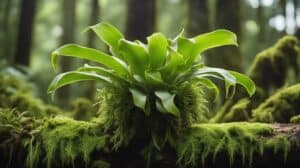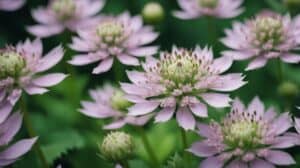Hippeastrum spp., commonly known as Amaryllis, is a popular and stunning flowering plant that is widely grown for its vibrant and colorful blooms.
With proper care and attention, these plants can produce beautiful flowers that brighten up any room or garden.
In this article, we will provide you with some tips and tricks for growing and blooming Amaryllis plants.

One of the most important factors for successful Amaryllis blooming is proper planting.
Amaryllis bulbs should be planted in a well-draining soil mix, with the top third of the bulb exposed above the soil.
These plants prefer bright, indirect sunlight and should be watered sparingly until the leaves appear.
Once the leaves have emerged, regular watering is necessary to encourage blooming.
Another key element for successful Amaryllis blooming is proper fertilization.
These plants require a balanced fertilizer with equal amounts of nitrogen, phosphorus, and potassium.
Fertilize the plant every two weeks during the growing season, and reduce fertilization once the plant has finished blooming.
With the right care and attention, your Amaryllis plant will produce stunning blooms that will bring joy and beauty to your home or garden.
Understanding Amaryllis Brilliance
Species Overview
Amaryllis (Hippeastrum spp.) is a genus of flowering bulbs native to South America.
The plants produce large, showy flowers that come in a variety of colors, including red, pink, white, and orange.
The flowers are trumpet-shaped and can be up to 8 inches across.
Amaryllis bulbs are typically sold in the fall for blooming during the winter holiday season.
There are over 90 species of Hippeastrum, and numerous hybrids have been developed for the horticultural trade.
The most common species grown as houseplants are H. puniceum, H. reticulatum, and H. vittatum.
These species are easy to grow and produce large, showy flowers.
Hippeastrum vs. Amaryllis
The terms “Hippeastrum” and “Amaryllis” are often used interchangeably, but they actually refer to two different genera of plants.
The confusion arises because the common name “amaryllis” is used to refer to both Hippeastrum and Amaryllis belladonna, a plant native to South Africa.
Hippeastrum bulbs are larger and rounder than Amaryllis bulbs, and they produce multiple flower stalks per bulb.
Amaryllis bulbs are smaller and produce only one flower stalk per bulb. Hippeastrum flowers are also larger and more showy than Amaryllis flowers.
In conclusion, understanding the differences between Hippeastrum and Amaryllis can help gardeners choose the right plant for their needs.
Whether you prefer the larger, showier flowers of Hippeastrum or the simplicity of Amaryllis, both genera offer a wide range of colors and varieties to choose from.
Cultivation Essentials

Selecting Bulbs
When selecting Amaryllis bulbs, it is important to choose ones that are firm, plump, and free from any signs of damage or disease.
The larger the bulb, the more flowers it will produce.
It is also recommended to choose bulbs that have already started to sprout, as they will bloom sooner.
Planting Guidelines
Amaryllis bulbs should be planted in well-draining soil with the neck of the bulb above the soil line.
The container should be large enough to accommodate the bulb and allow for root growth.
It is recommended to use a potting mix that is specifically formulated for bulbs.
Water the soil thoroughly after planting and keep it moist but not waterlogged.
Light and Temperature Requirements
Amaryllis bulbs require bright, indirect light to grow and bloom. They should be placed in a location that receives at least six hours of sunlight per day.
The ideal temperature range for Amaryllis growth is between 60-75°F (15-24°C).
Avoid placing the plant in direct sunlight or near heat sources such as radiators or fireplaces.
Following these cultivation essentials will help ensure that your Amaryllis plant produces beautiful, vibrant blooms.
Maintenance and Care

Watering Practices
Amaryllis plants require moderate watering.
Overwatering can lead to root rot, while under-watering can cause the leaves to wilt and the flowers to drop prematurely.
Water the plant when the top inch of soil feels dry to the touch.
During the active growth phase, water the plant more frequently, but reduce watering during the dormant phase.
Avoid getting water on the leaves and flowers, as this can cause fungal diseases.
Fertilizing Techniques
Fertilize amaryllis plants every 2-3 weeks during the active growth phase with a balanced fertilizer.
Use a fertilizer with an NPK ratio of 10-10-10 or 20-20-20. Reduce fertilizing during the dormant phase.
Over-fertilizing can lead to salt buildup in the soil, which can damage the roots.
Pest and Disease Management
Amaryllis plants are generally pest-resistant, but they can be susceptible to mealybugs and spider mites.
Check the plant regularly for signs of infestation, such as white, cottony masses or webbing.
If an infestation is detected, isolate the plant and treat it with an insecticidal soap or neem oil.
Amaryllis plants can also be susceptible to fungal diseases such as gray mold and leaf spot.
Avoid getting water on the leaves and flowers, and provide good air circulation to prevent fungal growth.
Overall, with proper maintenance and care, amaryllis plants can bloom beautifully year after year.
Encouraging Reblooming

Encouraging reblooming in Amaryllis plants can be a rewarding experience for any gardener. Here are some tips for getting your Hippeastrum spp.
to bloom again.
After-Bloom Care
After the initial bloom, it is important to continue caring for the plant. Deadhead the spent flowers to prevent seed production and conserve energy.
Keep the soil moist and fertilize the plant every two weeks with a balanced fertilizer.
Forcing Dormancy
In order for the plant to rebloom, it needs a period of dormancy. To force dormancy, stop watering the plant in late summer or early fall.
Once the leaves have turned yellow, cut them back to about two inches above the bulb. Store the bulb in a cool, dark place for at least six weeks.
Timing Blooms
To ensure blooms for a specific time, it is important to time the planting and dormancy periods. Plant the bulb 8-10 weeks before the desired bloom time.
For holiday blooms, plant in mid-October. After the initial bloom, follow the steps for forcing dormancy to ensure reblooming for the next holiday season.
By following these tips, you can enjoy the beauty of Amaryllis blooms year after year.
Frequently Asked Questions

How can I encourage my amaryllis to bloom more quickly?
To encourage your amaryllis to bloom more quickly, make sure to provide it with plenty of sunlight and warmth.
Keep the soil moist but not too wet, and fertilize regularly with a balanced fertilizer.
You can also try placing the plant in a cooler location for a few weeks before bringing it back to a warmer spot to stimulate blooming.
What are the ideal light conditions for growing amaryllis indoors?
Amaryllis plants require bright, indirect light to thrive. Place them in a sunny window or under a grow light for at least six hours a day.
Avoid direct sunlight, as this can burn the leaves and flowers.
What steps should I take after my amaryllis bulbs have finished blooming?
After your amaryllis bulbs have finished blooming, cut off the spent flowers and stalks.
Continue to water and fertilize the plant regularly, and provide it with plenty of light.
When the leaves begin to yellow and die back, stop watering and allow the plant to go dormant for a few months.
How do I properly plant amaryllis bulbs in pots?
To plant amaryllis bulbs in pots, choose a container that is at least 6 inches deep and has drainage holes in the bottom.
Fill the pot with a well-draining potting mix, leaving enough room for the bulb to be planted with its neck above the soil line.
Water the soil thoroughly after planting, and place the pot in a bright, warm spot.
Why isn’t my Hippeastrum flowering, and how can I fix it?
If your Hippeastrum isn’t flowering, it may be due to a lack of sunlight or nutrients.
Make sure to provide the plant with plenty of bright, indirect light and fertilize regularly with a balanced fertilizer.
You can also try placing the plant in a cooler location for a few weeks to stimulate blooming.
Can you give me tips for reflowering an amaryllis?
To encourage your amaryllis to reflower, make sure to provide it with plenty of sunlight and warmth.
Keep the soil moist but not too wet, and fertilize regularly with a balanced fertilizer.
After the plant has finished blooming, cut off the spent flowers and stalks and continue to care for the plant as usual.
With proper care, your amaryllis should bloom again in the following year.














